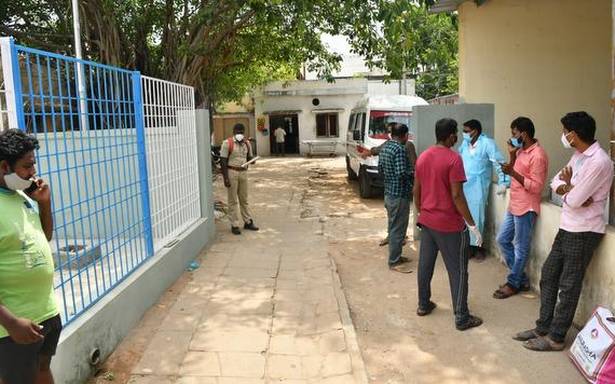Government hospitals in Dharmapuri and Krishnagiri have taken selective cover under the ICMR ‘Cause of Death’ protocol to undercount COVID-19 deaths
On Wednesday, the Government Dharmapuri Medical College Hospital administration was on a fire-fighting mode, fighting off queries on “rumours of 47 COVID deaths on a single day on Tuesday at the hospital.”
It started off with an unverifiable WhatsApp message that was subsequently denied by the hospital administration. “Take it as false information. Only 7 deaths are due to [COVID-19] positivity. The remaining include those admitted with symptoms, and swab negative patients suffering from complications as “sequel to COVID-19”,” said Dean of the hospital K. Amudavalli. “Those numbers are for 36 hours and not 12 hours, and include symptomatic patients, who need oxygen, with co-morbidities, they are all sequel to COVID-19,” said the Dean.
Similarly, at the Krishnagiri government medical college hospital, 23 deaths were recorded on Friday, but only 3 were recorded as COVID-19 deaths. Nine other bodies, however, were bagged for potential positivity as a precaution. “The virus remains for a maximum of 10 days, but the patient may develop other complications, persistent and COVID-19 related, and may not get discharged. That death after an RT-PCR negative test is not documented as COVID-19 as per the Indian Council of Medical Research (ICMR) protocol,” echoes N. Muthuselvan, dean of the Krishnagiri hospital.
This has signalled gross under-counting and under-reporting by government hospitals here as part of following ICMR protocol. To be clear, swab negativity at the time of fatality, days or weeks after testing positive will not find its way into the State bulletin, say the deans of the two government medical college hospitals here.
“The person might test negative after 5 days at the hospital, but the virus would have damaged the lungs causing infection for two weeks or two months — this “sequel to COVID-19” will not be counted as a COVID-19 death, because the ICMR guideline says so,” says Dr. Amuthavalli.
Government hospitals have selectively taken cover under the WHO death coding classification, reiterated by the ICMR Cause of Death (COD) manual for COVID 19. Under this, COVID-19 is documented as the underlying cause of death (UCOD) when an RT-PCR test is positive – with or without typical COVID-19 symptoms, when present with co-morbid symptoms (asthma, heart disease, type 1 diabetes). The death is recorded as such with a different code, when the test is negative – but clinical COVID-19 symptoms are present; as Probable COVID 19, when test is inconclusive, but symptoms present; or as Suspected COVID 19, when test result is awaited, but symptoms present.
But government hospitals here are recording only cases of deaths, with COVID-19 positivity at the time of death. “Incidental COVID-19 is not taken as COVID – someone may have hypertension, diabetes or other co-morbidities and when we test for COVID-19, they may test positive. The presentation is that of a disease, but not of COVID-19,” says N. Muthuselvan, Dean of Krishnagiri government medical college hospital.
But there is the catch. The second protocol of ICMR –COD manual highlights positivity with symptoms presented as co-morbid conditions atypical of COVID-19 symptoms, to be documented as COVID as UCOD.
What government hospitals cite as “COVID sequel” or “incidental COVID” is the sequence of events from the onset of the disease (COVID 19) leading upto the death of the patient, mentioned by the ICMR in its COD manual, but selectively ignored by the government hospitals for documenting death.
“We have been told orally in the meeting that only deaths within 10 days of admissions will be taken as COVID-19 deaths. But this is wrong because, once community transmission has started in a pandemic, every death should be counted as a pandemic death, as per international standards,” says a medical officer in Krishnagiri. It goes on the assumption that the virus is identifiable only for 10 days, any damage done by the virus after the person testing negative is not counted as a COVID-19 death.
But, the ICMR manual nowhere states that the UCOD should be documented to COVID-19 only if it occurs within a specific time of infection. It also details the recording of time between the onset of disease and death – which may be “hours, days, weeks or even years.”
“Of course there is -. We don’t even count SARI deaths (Severe Acute Respiratory Syndrome) as COVID-19 deaths,” says the medical officer. “For instance, a patient with breathlessness would rush only to the government hospital not a PHC (primary health centre). At the GH, we won’t spend time in collecting swabs from the patient, but start treating for SARI. When the patient dies, it is treated as a SARI death but not a COVID-19 death. It may be COVID-19, but since the swab is not collected, it is not counted,” says the medical officer. “The patient is handled, treated as per COVID-19 protocols, the body bagged as per COVID-19 protocols – only that the death is not counted.”
“To say, a person tested negative but subsequently died of lung infection due to COVID-19 (but the death is unrecorded), is not just disingenuous but fraud,” says T. Sundararaman, former Convenor of Jan Swasthya Abhiyan.
Tamil Nadu has had a good record of transparency in the first phase and if this is happening now, it is tragic, he adds. “These are innovations made locally to hide deaths. There is an international standard in COVID 19 death recording. It is not up to them to bring local innovations like new nomenclature. Nobody dies of diabetes unless there is COVID-19. At least, they should be reported as a separate category of reporting. This sort of obfuscation will not just lead to un-recording of mortality, it will lead to an actual rise in mortality,” he says.
Source: Read Full Article

